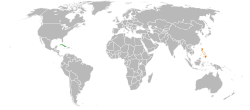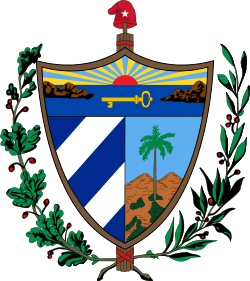Cuba–Philippines relations
 |
|
Cuba |
Philippines |
|---|---|
Cuba and the Philippines were both former Spanish colonies. Spanish rule on both countries was ended by the victory of the United States in the Spanish–American War as provisions of the Treaty of Paris giving Cuba independence and the Philippines becoming a new possession of the United States.
History
Early history
Cuba and the Philippines have been in existence for centuries. In the early 16th century, Filipinos reached Cuba and settled by the used of galleons. Filipinos who were brought by the Spaniards to Cuba were altar boys, catechism leaders, and church workers. The early migration of a few Filipinos to Cuba was made possible by the Manila-Acapulco Galleon trade. Pinar del Río is famous for their cigars, which were brought over from the Philippines by the Spanish because it was much closer to Europe and easier to oversee. Afterwards, some Filipinos moved to Havana's big Barrio Chino or Chinatown. The Philippines and Cuba were both dominated by Spain Crown for several centuries, which ended at the turn of the 19th century with Spain's defeat by the United States. Both countries became under American rule after Spain ceded Puerto Rico, Philippines, and Cuba to the United States for twenty million US dollars.[1][2] Later on, Cuba gained its Independence while the Philippines continued to be under the American rule. In July 4, 1946, the Philippines gained its independence. Formal diplomatic relations between the Philippines and Cuba were also established in July 1946.[3][4]
Contemporary era
Diplomatic relations between Cuba and the Philippines were disrupted in 1961. Relations were formally restored with the signing of a joint statement by former Prime Minister Fidel Castro and former Philippine First Lady Imelda Marcos in Havana on August 26, 1975.[5]
The Philippines, despite being a long-time of ally of the United States, which has currently unfavorable relations with Cuba, has voted against subsequent UN General Assembly resolutions against the United States embargo against Cuba.[6]
In July 2011, both countries celebrated their 65th year of diplomatic relations.[6]
On October 31, 2012, the Philippine government closed its embassy in Havana along with three other embassies in Stockholm, Sweden, Bucharest, Romania, Helsinki, Finland, and the consul office in Saipan. The closure was part of the Philippines' Department of Foreign Affairs austerity measures and restructuring plan.[7][8] The Philippines, however, assured the closing of its embassy in Cuba will not affect the diplomatic relations of the two countries. Presidential Spokesperson Edwin Lacierda said in a news briefing, "There will be no effect, closing down of Consular offices is internal to us, so there is no effect on them (concerned countries), as long as we have presence there... we [will] have diplomatic relations. The diplomatic relations is not diminished by the cutting down of Consular offices in their countries."[9]
In June 2013, former Cuban ambassador to the Philippines Jorge Rey Jiménez announced that they will close their embassy in Makati citing financial difficulties brought by the global economic crisis and the United States’ embargo. "Closing the embassy was a painful decision. Those who wish to transact with Cuba will have to deal with the Cuban embassy in Kuala Lumpur." Rey Jiménez said.[10]
Socio-cultural relations
Cuba and Philippines share socio-cultural similarities mostly due to their Hispanic heritage brought by Spanish colonial rule for more than three hundred years. Both countries are predominantly Catholics, and celebrates town fiestas. The two countries also share the concept of "Padre de Familiá" where the father heads the family and the mother, along the children, recognizes the father's decision. Spanish names and family names are also apparent among the two countries.[11]
People
Filipino Cubans include the Azcarraga Fessner family, whose patriarch was Marcelo de Azcarraga y Palmero, the first Prime Minister of Spain with Indian blood, whose mother was a Filipina from the Lizarrabal and Palmero families.[12]
The Pinar del Rio Province in Cuba, was formerly called "Nueva Filipinas" in the 18th century due to mass immigration of Filipinos and other Asians to the area to work in the region's tobacco industry. Asians immigrated to Cuba through the Manila-Acapulco galleon trade route and they were known generally known as "Chinos Manila".[13]
References
- ↑ "La liquidación del imperio colonial: Cuba y filipinas. El 98 y sus repercusiones." (in Spanish). Selectividad. Retrieved August 5, 2013.
- ↑ "La liquidación del imperio colonial: Cuba y Filipinas. El 98 y sus repercusiones." (in Spanish). Historiasiglo20. Retrieved August 5, 2013.
- ↑ "National Liberation Day of Cuba". Tempo. January 1, 2013. Retrieved August 5, 2013.
- ↑ "Stamps for 65th anniversary of PHL-Cuba diplomatic ties unveiled". GMA News. July 7, 2011. Retrieved August 5, 2013.
- ↑ "Philippines, Cuba Resume Relations". The Telegraph. August 28, 1975. Retrieved August 5, 2013.
- 1 2 "Cuba and the Philippines Mark 65th Anniversary of Diplomatic Relations". Television Camagüey. July 2, 2011. Retrieved August 5, 2013.
- ↑ Jerome Aning (March 8, 2012). "DFA assures closure of 10 embassies will have 'minimal' effect on services". Philippine Daily Inquirer. Retrieved August 5, 2013.
- ↑ "DFA shuts down five overseas posts, with five more to close this year". GMA News. September 4, 2012. Retrieved August 5, 2013.
- ↑ "Closure of Consular offices not to affect diplomatic ties - Philippine gov't". Zamboanga Times. March 9, 2012. Retrieved August 5, 2013.
- ↑ "Cuban embassy in Philippines closes down due to financial difficulties". Interaksyon. June 17, 2013. Retrieved August 5, 2013.
- ↑ Dr. Regino P. Paular. "CUBA, FILIPINAS y PUERTO RICO: Historical Vicissitudes and Sociocultural Affinities" (PDF). Philippine Academic Consortium for Latin American Studies. Retrieved August 5, 2013.
- ↑ "Introduction to Pinar del Rio". Frommer's. Retrieved August 5, 2013.
- ↑ "'New Philippines' in Cuba". Philippine Daily Inquirer. December 16, 2009.

